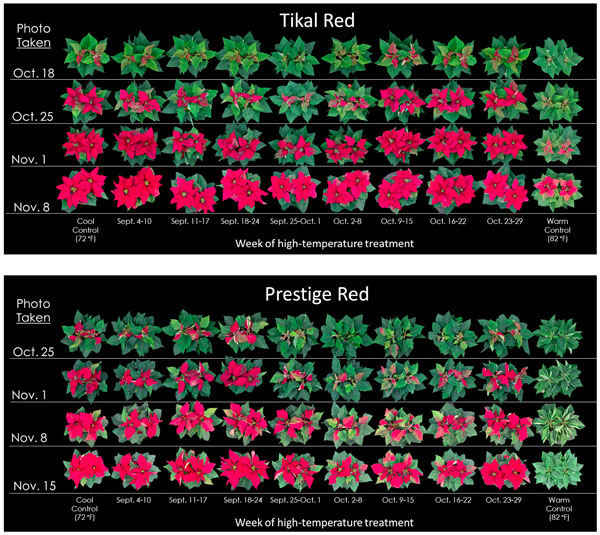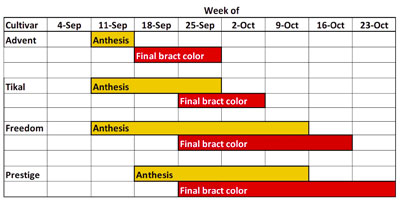7/1/2022
Poinsettia Heat Delay
Paul Millar & James E. Faust
High temperatures during the poinsettia production season can cause delays to flowering, often known as heat delay, which can put growers at risk of missing market dates. Additionally, high temperatures can cause a reduction in bract color development leading to lower-quality plants.
It hasn’t been entirely clear as to which weeks of the poinsettia season that the plants are most susceptible to heat delay, so we conducted experiments to identify the specific time when high temperatures are problematic. In this article, we describe the specific weeks that are most likely to cause heat delay on your poinsettia crop, and next month, we’ll describe the specific hours within a 24-hour day that are most likely to delay poinsettia flowering.
The study
Our previous work showed that poinsettias initiate and develop normal flowers at average daily temperatures of 72F (22C), while 82F (27C) will cause significant flowering delays. So, for this experiment, plants were grown at 72F throughout September and October; however, each week one group of plants was moved to an 82F greenhouse for an entire week before returning to the 72F greenhouse. Therefore, at the end of the experiment, one group of plants had been provided high temperatures during each week in September and October. Additionally, one group of plants remained in either the 72 and 82F greenhouses throughout the season, and these were considered to be the cool- and warm-temperature control groups.
 Figure 1. The effect of high average daily temperatures (82F/27C) delivered during different weeks in September and October for Tikal Red plants grown under natural daylength conditions.
Figure 1. The effect of high average daily temperatures (82F/27C) delivered during different weeks in September and October for Tikal Red plants grown under natural daylength conditions.
Figure 2. The effect of high average daily temperatures (82F/27C) delivered during different weeks in September and October for Prestige Red plants grown under natural daylength conditions.
Four varieties were grown: Advent, which is very early flowering and isn’t considered to be susceptible to heat delay; Tikal, which resembles Advent in appearance, but flowers 10 days later and is considered to have a low susceptibility to heat delay; Freedom, which is an old variety, but is still grown in south Florida due to its relatively low susceptibility to heat delay; and Prestige, which has been popular for decades, but is known to be susceptible to heat delay.
Sensitivity to heat delay for all cultivars began during the second or third week of September, presumably when night lengths became sufficiently long for floral initiation to proceed. Thus, earlier flowering cultivars were more sensitive to high temperatures a week before later-flowering cultivars. Cultivars also varied in the duration in which they were sensitive to high temperatures.
Figures 1 and 2 demonstrate the effect of high temperatures during specific weeks on bract color development in mid-October through mid-November for Tikal and Prestige. Advent and Tikal (Figure 1) were sensitive for a shorter duration until late-September and early-October, respectively, while Freedom and Prestige (Figure 2) remained sensitive to high temperatures into mid- and late-October, respectively.
The specific weeks of high-temperature sensitivity differed for anthesis (the primary cyathium shedding pollen) compared to final bract color (the amount of red shown in the top five bracts on each stem, Figure 3). Within the overall window of sensitivity identified for each cultivar, cyathia development was generally delayed by high temperatures in earlier weeks than bract development. This is most likely due to the fact that cyathia initiation occurs before bract initiation. It should also be noted that the plants weren’t equally sensitive to high temperatures to each of the weeks indicated in Figure 3. Typically, the sensitivity ramps up to a peak then declines until the plants are no longer sensitive.
The findings
Overall, Advent demonstrated the highest degree of heat tolerance both in terms of magnitude of response and duration of sensitivity (Figure 3). Advent is known to be amongst the most heat-tolerant cultivars, yet our study suggests that Advent is sensitive to high temperatures, although for a shorter time period and experiences less-severe delays from high temperatures compared to other cultivars.
Tikal had a relatively short window of sensitivity to high temperatures, but it did experience a high magnitude of response during that sensitive period. Freedom was more sensitive to high temperatures than was expected. Prestige was the most heat-sensitive of the four cultivars tested since it was sensitive to high temperatures for the longest period of time, e.g., September 11 through October 29. Also, note that the plants kept at high temperatures from September 4 to October 29 showed no flower development by November 15 for Prestige (Warm Control, Figure 2), while Tikal was delayed, but was making progress, to flower (Warm Control, Figure 1).
Tikal, Freedom and Prestige showed a higher magnitude of response to high temperatures compared to Advent. In fact, when high temperatures were applied during peak points of sensitivity for these cultivars, one week of high temperatures delayed flowering by more than one week.
For example, high temperatures applied for seven days from September 18 to September 24 delayed time to anthesis by nine to 10 days for Tikal and Freedom. This implies that high temperatures have a residual impact that extend beyond the time of the high temperature treatment. In contrast, Advent experienced <1 day of delay per day of high temperature during its sensitive period (September 11 to October 1).
 Figure 3. Periods of heat sensitivity identified regarding delays to anthesis and impact of bract color development for each of the four cultivars tested.
Figure 3. Periods of heat sensitivity identified regarding delays to anthesis and impact of bract color development for each of the four cultivars tested.
Growers have several options for mitigating the risk of heat delay. First and foremost, select cultivars that have a demonstrated heat tolerance. While we don’t expect any cultivar to be totally immune to heat delay, clearly some cultivars are substantially more tolerant than others. In recent years, breeders have done well to identify the heat tolerance of their cultivars, so their recommendations are invaluable.
The use of blackout curtains to increase night lengths is a proven strategy for reducing the impact of high temperatures. Poinsettias will experience a greater delay from high temperatures if the night lengths is ~12 hours, such as occurs during the naturally occurring photoperiods in September. Night lengths of 14 hours with black cloth provide a stronger flowering signal and therefore a lower sensitivity to high temperatures.
The most critical weeks to avoid heat delay are from mid-September to mid-October. During this time, do your best to minimize temperatures throughout the day and night. This means running pad and fan cooling systems throughout the night and early morning. Next month, we’ll demonstrate the importance of this approach. GT
Acknowledgement: The authors thank the USSDA-ARS Floriculture and Nursery Research Initiative for their financial support of this project.
Paul Millar recently finished his MS degree at Clemson University and now works at the Clemson University Research and Extension Center in Charleston, South Carolina. James Faust is a professor at Clemson University.